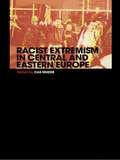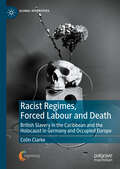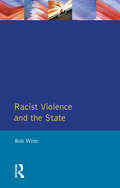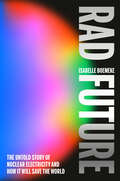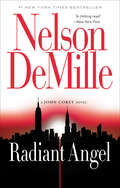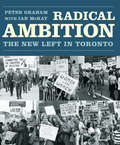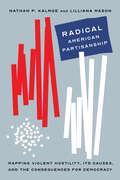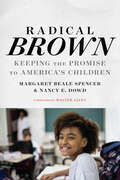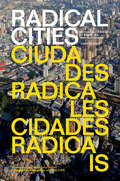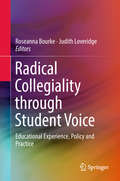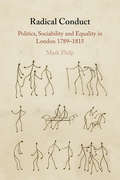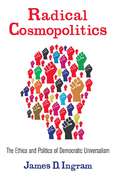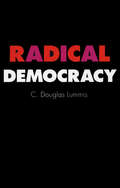- Table View
- List View
Racism, Violence and Harm: Ideology, Media and Resistance (Palgrave Studies in Crime, Media and Culture)
by Monish Bhatia Scott Poynting Waqas TufailThis book examines connections between racism, violence, and social harms, along with the parts played by media actors and institutions in sustaining these phenomena. The chapters present instances of racism from numerous countries in connection with state violence, media coverage of harms and violence against racialised others, including Roma, Palestinians, Indigenous Australians, Maori, African Americans, Mexican Americans, Muslim peoples, Black people in Portugal, Middle-Eastern people in Australia, and asylum seekers. The chapters analyse ideology while paying attention to history and global context, tracing intersectional dynamics including nexuses of racism, class, and gender. They focus on various aspects of violence, including state, colonial and imperialist violence and ideological violence. The book is necessarily interdisciplinary, but explicitly anti-racist and attentive to resistances. It traverses criminology, sociology, cultural studies, postcolonial studies, media studies, history, and cognate fields.
Racist America: Roots, Current Realities, and Future Reparations
by Joe R. Feagina look at the history and ideology of racism in America.
Racist Extremism in Central & Eastern Europe (Extremism and Democracy)
by Cas MuddeThis handbook on racist extremism in Central and Eastern Europe is the result of a unique collaborative research project of experts from the ten new and future post-communist EU member states. All chapters are written to a common framework, making it easier to compare individual countries and include sections on: racist extremist organizations (political parties, organizations, and subcultures the domestic and international legal framework members and types of racist extremist incidents state and civic responses to the threat. Mudde's conclusion examines the region as a whole and compares it with Western Europe.
Racist Logic: Markets, Drugs, Sex (Boston Review)
by Donna MurchThe history of international banking, the commodification of black masculinity, the buying and selling of women's eggs, Michelle Obama's dubious advice to black youth, and the workings of affirmative action at elite universities viewed through the lens of racial capitalism. In Racist Logic, lead essayist Donna Murch writes that “historically, the division between 'dope' and medicine was the race and class of users.” By using the concept of “racial capitalism” to examine the opioid crisis alongside the War on Drugs, Murch brings an otherwise familiar story into new territory. To understand the twisted logic that created the divergent responses to drug use—succor and sympathy for white users, prison and expulsion for people of color—Murch shows how a racialized regime of drug prohibitions led Purdue Pharma to market OxyContin specifically to whites. Alongside Murch, contributors consider how racial capitalism helps us understand the history of international banking, the commodification of black masculinity, the buying and selling of women's eggs, Michelle Obama's dubious advice to black youth, and the workings of affirmative action at elite universities. Contributors Michael Collins, Richard Thompson Ford, Helena Hansen, David Herzberg, Peter James Hudson, Jonathan Kahn, L.A. Kauffman, Julilly Kohler-Hausmann, Jordanna Matlon, Max Mishler, Donna Murch, Julie Netherland, Britt Rusert, Keeanga-Yamahtta Taylor, Alys Eve Weinbaum
Racist Regimes, Forced Labour and Death: British Slavery in the Caribbean and the Holocaust in Germany and Occupied Europe (Global Diversities)
by Colin ClarkeThis book compares the systems of exploitative race relations associated with two racist regimes – slavery in the British colonial Caribbean and forced labour in the Holocaust in Germany and the Nazi-occupied lands in Europe. Although each system was introduced by expansionist European powers, through racist enslavement, transportation, dehumanisation and the destruction of human life, the construction and operation of sugar plantations by African and Creole slave labour for the export of tropical products in the period 1650 to 1838 was different from the mass murder of Jewish and Gypsy civilians with the intention of creating a forced-labour regime and colonial-style ethnic cleansing during the Second World War.Though differentiated in time and place, the four principal common denominators that make feasible the detailed comparison of British Caribbean slavery and the Holocaust in Europe are racism, colonialism/occupation, slavery/forced labour, and death. Juxtaposition of these two companion studies will reveal comparisons and contrasts previously unexplored in the field of race relations under colonialism and the Holocaust. The book will be of interest to scholars and students of the social sciences and history, particularly those with an engagement with slavery and forced labour, the sociology of race and racism, and Holocaust studies.
Racist Violence and the State: A comparative Analysis of Britain, France and the Netherlands
by Rob WitteRacist Violence and the State is the first serious study to apply a comparative research-based approach to the study of racist violence in Britain, France and The Netherlands since 1945. Setting racist violence within a historical background of the post-imperialist legacy, the author presents an accessible, fascinating and highly original analysis of the development of public and state attitudes to racist violence over the past 50 years.
Rad Future: The Untold Story of Nuclear Electricity and How It Will Save the World
by Isabelle BoemekeWe&’re running out of time. Fossil fuels are choking the planet and renewable energy isn&’t cutting it. The solution has been hiding in plain sight all along.Nuclear.When most people hear that word, they go to a very bad place: bombs, Chernobyl, hazmat suits, radioactive fallout… the stuff of nightmares. But what if everything you think you know about nuclear is wrong?In Rad Future, science influencer Isabelle Boemeke shatters the fear and misinformation surrounding this technology and shows how the actual science tells a different story. It turns out that nuclear-generated electricity—nuclear electricity—is our best option for ensuring the future of the planet. Nuclear can power cities, desalinate water, create carbon-free fertilizer, and heat homes, all with the smallest environmental footprint of any energy source.Boemeke exposes how decades of fearmongering, a few dramatic (but preventable) disasters, and relentless bad PR have convinced the world that nuclear is dangerous when it&’s actually the key to an affordable, sustainable future. We&’ve fumbled the bag on the cleanest, most powerful energy source we have, and it&’s time to fix that.This isn&’t your typical science book. Boemeke&’s signature mix of humor, sass, and deep research makes Rad Future a wild ride through the science, history, and future of nuclear electricity. From Cold War politics to Hollywood-fueled paranoia to cutting-edge reactor designs, she details exactly how nuclear works and why it&’s our best shot at ending the climate crisis and creating a future of radical abundance. Rad Future is the first truly accessible breakdown of nuclear electricity, and it will leave you feeling stoked about what&’s possible.
Radar Imaging for Maritime Observation (Signal and Image Processing of Earth Observations)
by Fabrizio Berizzi Marco Martorella Elisa GiustiBased on the experiences of the Department of Information Engineering of the University of Pisa and the Radar and Surveillance System (RaSS) national laboratory of the National Interuniversity Consortium of Telecommunication (CNIT), Radar Imaging for Maritime Observation presents the most recent results in radar imaging for maritime observation. The book explores both the areas of sea surface remote sensing and maritime surveillance providing key theoretical concepts of SAR and ISAR imaging and more advanced and ad-hoc techniques for applications in maritime scenarios. The book is organized in two sections. The first section discusses the fundamentals of standard SAR/ISAR processing and novel imaging techniques, such as Bistatic, Passive, and, 3D Interferometric ISAR. The second section focuses on the applications and results obtained by processing real data from maritime observations like SAR image processing for oil spill, detection in SAR images and fractal analysis. Useful to both beginners and experts in maritime observation, this book provides several examples of (mainly space-borne) radar imaging of maritime targets. Nevertheless, the same principles and techniques apply to the case of manned or unmanned carriers and to ground and air moving targets.
Radiant Angel (A John Corey Novel #7)
by Nelson DeMillePrescient and chilling, DeMille's #1 New York Times bestselling novel takes us into the heart of a new Cold War with a clock-ticking plot that has Manhattan in its crosshairs. After a showdown with the notorious Yemeni terrorist known as The Panther, John Corey has left the Anti-Terrorist Task Force and returned home to New York City, taking a job with the Diplomatic Surveillance Group. Although Corey's new assignment with the DSG-surveilling Russian diplomats working at the U.N. Mission-is thought to be "a quiet end," he is more than happy to be out from under the thumb of the FBI and free from the bureaucracy of office life. But Corey realizes something the U.S. government doesn't: The all-too-real threat of a newly resurgent Russia. When Vasily Petrov, a colonel in the Russian Foreign Intelligence Service posing as a diplomat with the Russian U.N. Mission, mysteriously disappears from a Russian oligarch's party in Southampton, it's up to Corey to track him down. What are the Russians up to and why? Is there a possible nuclear threat, a so-called radiant angel? Will Corey find Petrov and put a stop to whatever he has planned before it's too late? Or will Corey finally be outrun and outsmarted, with America facing the prospect of a crippling attack unlike anything it's ever seen before?
Radiant Angel (A John Corey Novel)
by Nelson Demille"A soft breeze fluttered the white, blue, and red Russian flag in front of the U.N. mission. I remember when the Soviet hammer and sickle flew there. I kind of miss the Cold War. But I think it's back."<P><P> After a showdown with the notorious Yemeni terrorist known as The Panther, John Corey has left the Anti-Terrorist Task Force and returned home to New York City, taking a job with the Diplomatic Surveillance Group. Although Corey's new assignment with the DSG-surveilling Russian diplomats working at the U.N. Mission-is thought to be "a quiet end," he is more than happy to be out from under the thumb of the FBI and free from the bureaucracy of office life.<P> But Corey realizes something the U.S. government doesn't: The all-too-real threat of a newly resurgent Russia.<P> When Vasily Petrov, a colonel in the Russian Foreign Intelligence Service posing as a diplomat with the Russian U.N. Mission, mysteriously disappears from a Russian oligarch's party in Southampton, it's up to Corey to track him down. What are the Russians up to and why? Is there a possible nuclear threat, a so-called radiant angel? Will Corey find Petrov and put a stop to whatever he has planned before it's too late? Or will Corey finally be outrun and outsmarted, with America facing the prospect of a crippling attack unlike anything it's ever seen before?<P> Prescient and chilling. DeMille's new novel takes us into the heart of a new Cold War with a clock-ticking plot that has Manhattan in its crosshairs.
Radiant Infrastructures: Media, Environment, and Cultures of Uncertainty (Sign, Storage, Transmission)
by Rahul MukherjeeIn Radiant Infrastructures Rahul Mukherjee explores how the media coverage of nuclear power plants and cellular phone antennas in India—what he calls radiant infrastructures—creates environmental publics: groups of activists, scientists, and policy makers who use media to influence public opinion. In documentaries, lifestyle television shows, newspapers, and Bollywood films, and through other forms of media (including radiation-sensing technologies), these publics articulate contesting views about the relationships between modernity, wireless signals, and nuclear power. From testimonies of cancer patients who live close to cell towers to power plant operators working to contain information about radiation leaks and health risks, discussions in the media show how radiant infrastructures are at once harbingers of optimism about India's development and emitters of potentially carcinogenic radiation. In tracing these dynamics, Mukherjee expands understandings of the relationship between media and infrastructure and how people make sense of their everyday encounters with technology and the environment.
Radiant Terminus
by Antoine Volodine Jeffrey ZuckermanPart post-apocalyptic adventure story and part scathing critique of humanity, Volodine’s award-winning novel takes place after the fall of the Second Soviet Union against a bleak, almost Tarkovskian landscape. A number of damaged individuals wander this nuclear winter seeking safety, both from the elements and from the psychotic Solovyei who invades people’s dreams and torments them for thousands of years.
Radiation Detection: Concepts, Methods, and Devices
by J. Kenneth Shultis Douglas McGregorRadiation Detection: Concepts, Methods, and Devices provides a modern overview of radiation detection devices and radiation measurement methods. The book topics have been selected on the basis of the authors’ many years of experience designing radiation detectors and teaching radiation detection and measurement in a classroom environment. This book is designed to give the reader more than a glimpse at radiation detection devices and a few packaged equations. Rather it seeks to provide an understanding that allows the reader to choose the appropriate detection technology for a particular application, to design detectors, and to competently perform radiation measurements. The authors describe assumptions used to derive frequently encountered equations used in radiation detection and measurement, thereby providing insight when and when not to apply the many approaches used in different aspects of radiation detection. Detailed in many of the chapters are specific aspects of radiation detectors, including comprehensive reviews of the historical development and current state of each topic. Such a review necessarily entails citations to many of the important discoveries, providing a resource to find quickly additional and more detailed information. This book generally has five main themes: Physics and Electrostatics needed to Design Radiation Detectors Properties and Design of Common Radiation Detectors Description and Modeling of the Different Types of Radiation Detectors Radiation Measurements and Subsequent Analysis Introductory Electronics Used for Radiation Detectors Topics covered include atomic and nuclear physics, radiation interactions, sources of radiation, and background radiation. Detector operation is addressed with chapters on radiation counting statistics, radiation source and detector effects, electrostatics for signal generation, solid-state and semiconductor physics, background radiations, and radiation counting and spectroscopy. Detectors for gamma-rays, charged-particles, and neutrons are detailed in chapters on gas-filled, scintillator, semiconductor, thermoluminescence and optically stimulated luminescence, photographic film, and a variety of other detection devices.
Radiation Nation: Three Mile Island and the Political Transformation of the 1970s
by Natasha ZaretskyOn March 28, 1979, the worst nuclear reactor accident in U.S. history occurred at the Three Mile Island power plant in Central Pennsylvania. Radiation Nation tells the story of what happened that day and in the months and years that followed, as local residents tried to make sense of the emergency. The near-meltdown occurred at a pivotal moment when the New Deal coalition was unraveling, trust in government was eroding, conservatives were consolidating their power, and the political left was becoming marginalized. Using the accident to explore this turning point, Natasha Zaretsky provides a fresh interpretation of the era by disclosing how atomic and ecological imaginaries shaped the conservative ascendancy.Drawing on the testimony of the men and women who lived in the shadow of the reactor, Radiation Nation shows that the region's citizens, especially its mothers, grew convinced that they had sustained radiological injuries that threatened their reproductive futures. Taking inspiration from the antiwar, environmental, and feminist movements, women at Three Mile Island crafted a homegrown ecological politics that wove together concerns over radiological threats to the body, the struggle over abortion and reproductive rights, and eroding trust in authority. This politics was shaped above all by what Zaretsky calls "biotic nationalism," a new body-centered nationalism that imagined the nation as a living, mortal being and portrayed sickened Americans as evidence of betrayal. The first cultural history of the accident, Radiation Nation reveals the surprising ecological dimensions of post-Vietnam conservatism while showing how growing anxieties surrounding bodily illness infused the political realignment of the 1970s in ways that blurred any easy distinction between left and right.
Radiation Protection: A Guide for Scientists, Regulators, and Physicians, Fourth Edition
by Jacob ShapiroThis highly successful manual has served for nearly three decades as the definitive guide to the safe use of radioactive materials. Completely revised and updated, the fourth edition presents a new dimension by adding coverage of nonionizing radiation, and is thus concerned with the entire field of radiation protection. The author takes the novel approach of introducing the whole range of energies possessed by particles and electromagnetic waves at the beginning of the text, thus integrating coverage of ionizing and nonionizing radiation rather than considering them as two separate disciplines. He goes on to cover the entire spectrum of radiation sources, including radionuclides, x-ray machines, accelerators, nuclear reactors, power lines, microwave towers, and cellular phones. With its expanded coverage, including a broader focus on public health issues, this new volume will serve as an important training and reference resource, not only for research scientists, physicians, and engineers, but for regulatory officials, attorneys, engineers, and environmental health and safety professionals. The breadth of citations alone makes this resource invaluable.
Radical Ambition: The New Left in Toronto
by Peter GrahamWriting for Maclean’s magazine in 1965, Peter Gzowski saw something different about the new generation of the left. They were not the agrarian radicals of old. They did not meet in union halls. Nor were they like the Beatniks that Gzowski had rubbed shoulders with in college. “The radicals of the New Left … differ from their predecessors not only in the degree of their protest but in its kind. They are a new breed.” Members of the New Left placed the ideals of self-determination and community at the core of their politics. As with all leftists, they sought to transcend capitalism. But in contrast to older formations, New Leftists emphasized solidarity with national liberation movements challenging imperialism around the world. They took up organizational forms that anticipated—in their direct, grassroots, community-based democracy—the liberated world of the future. Radical Ambition is the first book to explore the history of this dynamic movement and reveal the substantial social changes it won for the people of Toronto.
Radical American Partisanship: Mapping Violent Hostility, Its Causes, and the Consequences for Democracy (Chicago Studies in American Politics)
by Nathan P. Kalmoe Lilliana MasonRadical partisanship among ordinary Americans is rising, and it poses grave risks for the prospects of American democracy. Political violence is rising in the United States, with Republicans and Democrats divided along racial and ethnic lines that spurred massive bloodshed and democratic collapse earlier in the nation’s history. The January 6, 2021 insurrection and the partisan responses that ensued are a vivid illustration of how deep these currents run. How did American politics become so divided that we cannot agree on how to categorize an attack on our own Capitol? For over four years, through a series of surveys and experiments, Nathan P. Kalmoe and Lilliana Mason have been studying radicalism among ordinary American partisans. In this groundbreaking book, they draw on new evidence—as well as insights from history, psychology, and political science—to put our present partisan fractiousness in context and to explain broad patterns of political and social change. Early chapters reveal the scope of the problem, who radical partisans are, and trends over time, while later chapters identify the conditions that partisans say justify violence and test how elections, political violence, and messages from leaders enflame or pacify radical views. Kalmoe and Mason find that ordinary partisanship is far more dangerous than pundits and scholars have recognized. However, these findings are not a forecast of inevitable doom; the current climate also brings opportunities to confront democratic threats head-on and to create a more inclusive politics. Timely and thought-provoking, Radical American Partisanship is vital reading for understanding our current political landscape.
Radical Approaches to the Care Crisis: Solidarity, Community and a National Care Service
by Anne M. GrayThis book explores the critical issue of how to manage the ever-increasing demand for social care in Britain’s ageing society. With informal care from family members and friends now the dominant form of adult social care in the UK, this precarious system is struggling to provide enough support. Exploring the relationship between formal and informal care, this book develops ideas for a ‘caring economy’, showing the potential to integrate paid-for and unpaid care within a framework of solidarity based on the strengths of the community, working to improve the quality and quantity of state-funded care provision while sharing unpaid support more widely as a community responsibility.
Radical Brown: Keeping the Promise to America's Children (Race and Education)
by Nancy E. Dowd Margaret Beale SpencerA rallying cry for equitable education informed by a revolutionary re-reading of Brown v. Board of Education, on the 70th anniversary of the ruling
Radical Cities
by Justin McguirkWhat makes the city of the future? How do you heal a divided city? In RADICAL CITIES, Justin McGuirk travels across Latin America in search of the activist architects, maverick politicians and alternative communities already answering these questions. From Brazil to Venezuela, and from Mexico to Argentina, McGuirk discovers the people and ideas shaping the way cities are evolving. Ever since the mid twentieth century, when the dream of modernist utopia went to Latin America to die, the continent has been a testing ground for exciting new conceptions of the city. An architect in Chile has designed a form of social housing where only half of the house is built, allowing the owners to adapt the rest; Medillín, formerly the world's murder capital, has been transformed with innovative public architecture; squatters in Caracas have taken over the forty-five-storey Torre David skyscraper; and Rio is on a mission to incorporate its favelas into the rest of the city. Here, in the most urbanised continent on the planet, extreme cities have bred extreme conditions, from vast housing estates to sprawling slums. But after decades of social and political failure, a new generation has revitalised architecture and urban design in order to address persistent poverty and inequality. Together, these activists, pragmatists and social idealists are performing bold experiments that the rest of the world may learn from.From the Hardcover edition.
Radical Civility: A Study in Utopia and Democracy (Routledge Studies in Social and Political Thought)
by Jason CaroRadical Civility unearths civility’s extraordinary potential by addressing why the virtue has fallen into crisis, recalling the injunctions that transpose utopia upon the stingy politics of likelihood, and by offering a vision of citizens who find purpose in dignifying each other. Jason Caro takes a three-pronged approach; first, identifying the effects of the misuse of civility, then expanding the meaning of civility, and finally offering applied examples of civility. Civility bears its participants to utopia. Such utopia has many forms: the politics of unlikelihood, the civil community, the ideal civility situation, or charmocracy. Unlike many studies of political manners, Caro embraces the relation between the virtue and politeness. Civility is then the effort to have politics charm. Caro draws out the full potential of the virtue by observing how such politeness is a particular mode of communicative action whereby participants are not merely exchanging face-saving gestures but constructing utopia. This radical stance raises the stakes of the debate on civility by setting the book implacably against realism and its politics of likelihood. It will appeal to those in the social sciences, cultural studies, social psychology, philosophy, communication, and peace studies.
Radical Collegiality through Student Voice: Educational Experience, Policy and Practice
by Roseanna Bourke Judith LoveridgeThis book celebrates the rights of the child, through including student voice in educational matters that affect them directly. It focuses on the experiences of children and young people and explores how our educational policies, practices and research endeavours enable educators to help young people tell their own stories. The respective chapters illustrate how listening to young people can help them attain new positions of power, even though doing so often creates discomfort and requires a radical change on the part of the adult establishment. Further, the book challenges researchers, teachers and practitioners to reconsider how students are involved in research and policy agendas, and to what extent radical collegiality can create fundamental and positive changes in the lives of these learners. In recent decades, greater attention has been paid across policy, practice and research discourses to involving children more meaningfully and actively in decisions about their participation in both formal and informal educational settings. The book’s goal is to illustrate how researchers have systematically involved students in the pursuit of a richer understanding of educational experiences, policy and practice through the eyes and ears of young people, and through their own cultural lens.
Radical Conduct: Politics, Sociability and Equality in London 1789-1815
by Mark PhilpWhile the French Revolution drew immense attention to French radicals and their ideas, London also played host to a radical intellectual culture. Drawing on both original material and a range of interdisciplinary insights, Radical Conduct transforms our understanding of the literary radicalism of London at the time of the French Revolution. It offers new accounts of people's understanding of and relationship to politics, their sense of the boundaries of privacy, their practices of sociability, friendship, gossip and discussion, the relations between radical men and women, and their location in a wider world of sound and movement in the period. It reveals a series of tensions between many radicals' deliberative practices and aspirations and the conventions and practices in which their behaviour remained embedded. Exploring these relationships and pressures reveals the fractured world of London society and politics, dramatically illuminating both the changing fortunes of radical men and women, and the intriguing uncertainties that drove some of the government's repressive policies.
Radical Cosmopolitics: The Ethics and Politics of Democratic Universalism (New Directions in Critical Theory #28)
by James IngramWhile supporting the cosmopolitan pursuit of a world that respects all rights and interests, James D. Ingram believes political theorists have, in their approach to this project, compromised its egalitarian and emancipatory principles. Focusing on recent debates without losing sight of cosmopolitanism's ancient and Enlightenment roots, Ingram confronts the philosophical difficulties of defending universal ideals and the implications for ethics and political theory.In morality as in politics, theorists have generally focused first on discovering universal values and second on their implementation. Ingram argues that only by prioritizing the development and articulation of universal values through political action in the fight for freedom and equality can theorists do justice to these efforts and cosmopolitanism's universal vocation. Only by proceeding from the local to the global, from the bottom up rather than from the top down, on the basis of political practice rather than moral ideals, can we salvage moral and political universalism. In this book, Ingram provides the clearest, most systematic account yet of this schematic reversal and its radical possibilities.
Radical Democracy
by Douglas C. LummisC. Douglas Lummis writes as if he were talking with intelligent friends rather than articulating political theory. He reminds us that democracy literally means a political state in which the people (demos) have the power (kratia). The people referred to are not people of a certain class or gender or color. They are, in fact, the poorest and largest body of citizens. Democracy is and always has been the most radical proposal, and constitutes a critique of every sort of centralized power. Lummis distinguishes true democracy from the inequitable incarnations referred to in contemporary liberal usage. He weaves commentary on classic texts with personal anecdotes and reflections on current events. Writing from Japan and drawing on his own experience in the Philippines at the height of People's Power, Lummis brings a cross-cultural perspective to issues such as economic development and popular mobilization. He warns against the fallacy of associating free markets or the current world economic order with democracy and argues for transborder democratic action.Rejecting the ways in which technology imposes its own needs, Lummis asks what work would look like in a truly democratic society. He urges us to remember that democracy should mean a fundamental stance toward the world and toward one’s fellow human beings. So understood, it offers an effective cure for what he terms "the social disease called political cynicism." Feisty and provocative, Radical Democracy is sure to inspire debate.


